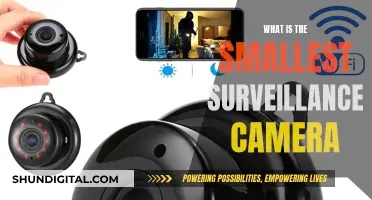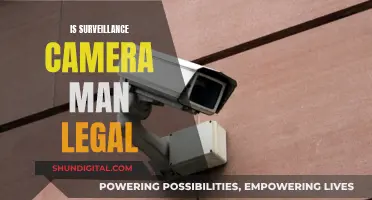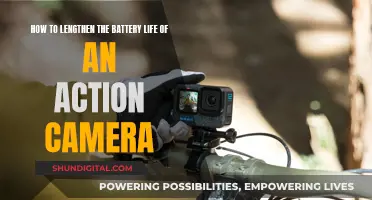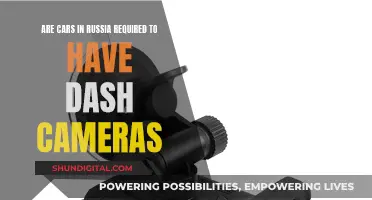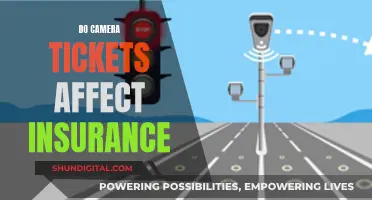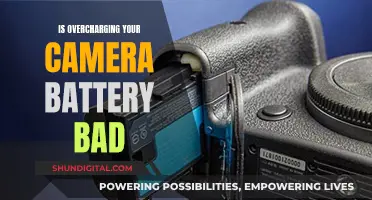
Traffic light cameras, also known as red-light cameras, are used across the UK to monitor and enforce traffic signals at intersections. These cameras use radar technology and ground sensors to detect vehicles that cross advanced stop lines when the traffic light displays a red signal. They are typically installed at busy junctions or high-risk areas to improve road safety and minimise accidents. While not all traffic lights have cameras, it is recommended to treat every junction as if there is one to ensure safe and responsible driving.
In the UK, the consequences of running a red light can include a fine and penalty points on your driving licence. The registered owner of the vehicle will receive a Notice of Intended Prosecution (NIP), which must be addressed within the specified timeframe. While it is possible to appeal a penalty notice, running a red light is considered a strict liability offence, making it challenging to evade responsibility.
| Characteristics | Values |
|---|---|
| Purpose | To monitor and enforce traffic signals at intersections |
| Operation | Triggered when a vehicle enters an intersection after the traffic signal turns red |
| Enforcement | Authorities review the captured images or videos, and if a violation is confirmed, a ticket is issued to the owner of the vehicle |
| Technology | Radar, sensors, ground loops, laser |
| Penalty | £100 fine and 3 points on the driving license |
| Notification | A Notice of Intended Prosecution (NIP) is sent to the registered owner of the vehicle |
| Response Time | 14 days to receive the NIP, 28 days to respond to the NIP |
| Appeal | Possible with mitigating circumstances or technical glitches |
| Camera Locations | Major cities, busy intersections, congested areas, roads with a history of accidents |
| Camera Appearance | Large square or rectangular boxes in silver, yellow, or white |
What You'll Learn

What are traffic cameras used for?
Traffic cameras are used to monitor and enforce traffic signals at intersections. They are also used to monitor traffic levels on motorways and trunk roads.
In the UK, there are more than 1,500 traffic cameras monitoring traffic across motorways and major trunk roads in England. These cameras are used to manage traffic and provide useful information to Highways England on how road users make use of the network. For example, they can help identify when traffic levels are likely to peak and when traffic is free-flowing.
Traffic cameras are also used to monitor and enforce speed limits. While they are not present at every traffic intersection or road, they are typically installed at specific locations, such as busy junctions or congested areas, to monitor traffic conditions, enforce traffic laws, and enhance public safety.
In addition, some traffic cameras are equipped with automatic number plate recognition (ANPR) technology, which can be used to monitor a motorist's journey on main roads across the country.
Overall, traffic cameras play a crucial role in promoting safe and responsible driving, reducing traffic violations, and improving road safety.
Best Car Camera Reviews: Our Top Picks Compared
You may want to see also

How do traffic light cameras work?
Traffic light cameras, also known as red-light cameras, are used to monitor and enforce traffic signals at intersections. They are typically placed at busy junctions or congested areas to monitor traffic conditions, enforce traffic laws, and enhance road safety. These cameras use a combination of radar technology and ground sensors to detect vehicles that violate traffic signals. When a violation is detected, the camera is triggered to capture evidence, such as photographs or videos, of the offence. The authorities then review the captured evidence, and if a violation is confirmed, a ticket or fine is issued to the owner of the vehicle.
Red-light camera systems usually consist of one or more triggers, with cameras positioned at the corners of an intersection on poles a few yards high. These cameras point inward to capture vehicles from different angles as they drive through the intersection. Some systems use film cameras, but most newer systems use digital cameras. The cameras are synchronised with the traffic signals to catch drivers who fail to stop when the light is red.
In addition to red-light cameras, there are also speed cameras and traffic sensor cameras. Speed cameras detect and issue tickets to drivers who exceed the posted speed limit. On the other hand, traffic sensor cameras monitor the flow of traffic and road conditions, and they do not issue violations. Overall, these camera systems play a crucial role in promoting safe and responsible driving, deterring red-light running, and improving road safety.
Boosting Wi-Fi for Surveillance Cameras: Tips and Tricks
You may want to see also

What do red light cameras look like?
Red light cameras in the UK are designed to be inconspicuous and blend into their surroundings. They are typically mounted on high poles or brackets near intersections, with a distinctive lens at the front for capturing images or videos of vehicles. The specific design and appearance of red light cameras may vary, but they are usually enclosed in weather-resistant casings, which can be white, yellow, or silver in colour.
Some red light cameras may rarely have amber flashing lights to indicate their presence, but they are often difficult to spot as they blend in with their surroundings. These cameras might resemble smaller CCTV cameras, either attached to traffic light posts or nearby poles, and are usually protected by a weather-resistant black casing, resembling a small black tube.
While the exact locations of red light cameras can change over time, they are typically installed at intersections where there is a higher risk of violations or where there have been previous incidents or concerns related to red light running.
It is important to note that not all red lights in the UK have cameras, and their presence can be rare. However, it is always advisable to adhere to traffic lights and treat every intersection as if there are cameras to ensure road safety and compliance with traffic laws.
Syncing Camera to Computer: Easy Steps to Follow
You may want to see also

What happens if you accidentally go through a red light?
Traffic light cameras, also known as red-light cameras, are commonplace at major junctions and crossings in the UK. They are designed to enforce some of the most important rules of the road and discourage people from driving through red lights. If you accidentally go through a red light, it may not be clear whether or not you've been caught.
Red-light cameras use radar technology and ground sensors to detect vehicles that pass the white stop line when the light is red. Some cameras may give you a small grace period (less than half a second) after the light turns red, while others will take a photo immediately. If a camera captures your vehicle running a red light, it will trigger a flash to record evidence of the violation. However, not all cameras are always operational, and some newer models use an infra-red flash that is invisible to the driver. Therefore, you may not know immediately if you've been caught.
If your vehicle is captured by a red-light camera, you will receive a Notice of Intended Prosecution (NIP) within 14 days. The NIP will be sent to the registered owner of the vehicle, asking them to name the offending driver within 28 days. The notice will typically include an admission of guilt and a fixed penalty fine, which is usually £100 for running a red light. You will also receive three penalty points on your driving licence, which will stay on your record for four years.
If you fail to respond to the NIP, provide incorrect details, or dispute the offence, you could face prosecution, six penalty points, and a maximum fine of £1000. However, you have the right to appeal a penalty notice if you believe you had mitigating circumstances for running the red light. For example, you may be able to prove that you did not go through the red light or prove there was a defect with the light or related signage.
In summary, accidentally going through a red light can result in a fine and penalty points, but it is unlikely to result in an immediate loss of your licence unless you already have penalty points. However, it is important to treat every junction with caution and comply with traffic signals to ensure your safety and that of other road users.
Consequences of Unpaid Camera Tickets in Newburgh Heights
You may want to see also

Can I appeal a fine for running a red light?
Traffic light cameras, also known as red-light cameras, are used in the UK to monitor and enforce traffic signals at intersections. These cameras use a combination of radar technology and ground sensors to capture instances of vehicles crossing advanced stop lines when the traffic light displays a red signal. The camera is triggered when a vehicle in motion violates the traffic signal, capturing evidence of the violation.
If you have been caught by a red-light camera, you will receive a Notice of Intended Prosecution (NIP), which includes photographic evidence of the violation, such as images of your vehicle and license plate, along with details such as the date, time, and location of the incident. The NIP will be sent to the registered owner of the vehicle, who is required to provide the name of the offending driver within 28 days. In most cases, the NIP will offer the option to admit guilt and pay a fixed penalty fine instead of going to court.
You have the right to appeal a red-light camera penalty notice if you feel you had mitigating circumstances for running the red light. For example, you may be able to prove that:
- You did not go through the red light.
- There was a defect with the light or related signage.
- Special circumstances existed that influenced your actions.
It is important to note that successfully appealing a red-light camera fine is difficult. As a "strict liability" offence, simply insisting that you "didn't intend" to run the light is unlikely to be a successful defence if there is photographic evidence proving otherwise.
If your appeal is unsuccessful, you can choose to pay the fine or have the matter resolved in court by a magistrate. However, courts rarely show much leniency in these cases, and the legal process can be expensive and complex.
Car Cameras: Privacy or Security?
You may want to see also
Frequently asked questions
If a vehicle is caught by a traffic light camera, the registered owner will receive a Notice of Intended Prosecution (NIP) within 14 days, asking them to provide the name of the driver at the time of the offence. The owner then has 28 days to complete and return the NIP.
Traffic light cameras use radar technology and ground sensors placed on the road to capture instances of vehicles crossing advanced stop lines when the traffic light displays a red signal.
If you accidentally go through a red light, there's a chance nothing will happen. However, if you are photographed, you will receive an NIP in the post, which will likely result in a fine and penalty points on your licence.


